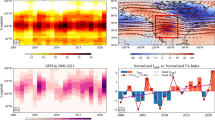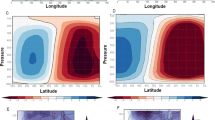Abstract
The daytime boundary-layer heating process and the air-land heat budget were investigated over the coastal sea-breeze region by means of observations over the Sendai plain in Japan during the summer. In this area, the onset of the sea breeze begins at the coast around 0900 LST, intruding about 35 km inland by late afternoon. The cold sea breeze creates a temperature difference of over 10°C between the coastal and inland areas in the afternoon. On the other hand, warm air advection due to the combination of the counter-sea breeze and land-to-sea synoptic wind occurs in the layer above the cold sea breeze in the coastal region. Owing to this local warm air advection, there is no significant difference in the daytime heating rate over the entire atmospheric boundary layer between the coastal and inland areas. The sensible heat flux from the land surface gradually decreases as distance from the coastline increases, being mainly attributed to the cold sea breeze. The daytime mean cold air advection due to the sea breeze is estimated asQ localadv =−29 W m−2 averaged over the sea breeze region (0∼35 km from the coastline). This value is 17% of the surface sensible heat fluxH over the same region. The results of a two-dimensional numerical model show that the value ofQ localadv /H is strongly affected by the upper-level synoptic wind direction. The absolute value ofQ localadv /H becomes smaller when the synoptic wind has the opposite direction of the sea breeze. This condition occurred during the observations used in the present study.
Similar content being viewed by others
References
Bhumralker, C. N.: 1975, ‘Numerical Experiments on the Computation of Ground Surface Temperature in an Atmospheric General Circulation Model’,J. Appl. Meteorol. 14, 1246–1258.
Bougeault, P.: 1983, ‘A Non-reflective Upper Boundary Condition for Limited-height Hydrostatic Model’,Mon. Weather Rev. 111, 420–429.
Kikuchi, Y., Arakawa, S., Kimura, F., Shirasaki, K. and Nagano, Y.: 1981, ‘Numerical Study on the Effects of Mountains on the Land and Sea Breeze Circulation in the Kanto District’,J. Meteorol. Soc. Japan 59, 723–738.
Kimura, F. and Arakawa, S.: 1983, ‘A Numerical Experiment of the Nocturnal Low Level Jet over the Kanto Plain’,J. Meteorol. Soc. Japan 61, 848–861.
Kimura, F. and Takahashi, S.: 1991, ‘The Effects of Land-use and Anthropogenic Heating on the Surface Temperature in the Tokyo Metropolitan Area: a Numerical Experiment’,Atmos. Envir. 25B, 155–164.
Klemp, J. B. and Durran, D. R.: 1983, ‘An Upper Boundary Condition Permitting Internal Gravity Wave Radiation in Numerical Mesoscale Models’,Mon. Weather Rev. 111, 430–444.
Kraus, H., Hacker, J. M. and Hartmann, J.: 1990, ‘An Observational Aircraft-based Study of Seabreeze Frontogenesis’,Boundary-layer Meteorol. 53, 223–265.
Kuwagata, T. and Kondo, J.: 1990, ‘Estimation of Aerodynamic Roughness at the Regional Meteorological Station (AMeDAS) in the Central Part of Japan’,Tenki,37, 197–201 (in Japanese).
Kuwagata, T., Sumioka, M., Masuko, N. and Kondo, J.: 1990a, ‘The Daytime PBL Heating Process over Complex Terrain in Central Japan under Fair and Calm Weather Conditions: Part I, Mesoscale Circulation and the PBL Heating Rate’,J. Meteorol. Soc. Japan 68, 625–638.
Kuwagata, T., Masuko, N., Sumioka, M. and Kondo, J.: 1990b, ‘The Daytime PBL Heating Process over Complex Terrain in Central Japan underFair and Calm Weather Conditions: Part II, Regional Heat Budget, Convective Boundary Layer Height and Surface Moisture Availability’,J. Meteorol. Soc. Japan 68, 639–650.
Kondo, J., Kuwagata, T., and Haginoya, S.: 1989, ‘Heat Budget Analysis of Nocturnal Cooling and Daytime Heating in a Basin’,J. Atmos. Sci. 46, 2917–2933.
Kondo, J. and Watanabe, T.: 1992, ‘Studies on the Bulk Transfer Coefficients over a Vegetated Surface with a Multilayer Energy Budget Model’,J. Atmos. Sci. 49, 2183–2199.
Lasic, A. A. and Hansen, J. E.: 1974, ‘A Parameterization for Absorption of Solar Radiation in the Earth's Atmosphere’,J. Atmos. Sci. 31, 118–133.
Mellor, G. L. and Yamada, T.: 1974, ‘A Hierarchy of Turbulence Closure Models of Planetary Boundary Layers’,J. Atmos. Sci. 31, 1791–1805.
Yamamoto, G.: 1952, ‘On a Radiation Chart’,Sci. Rep. Tohoku Univ., Ser. 5, Geophysics 4, 9–23.
Yoshikado, H.: 1990, ‘Vertical Structure of the Sea Breeze Penetrating through a Large Urban Complex’,J. Appl. Meteorol. 29, 878–891.
Yoshikado, H. and Kondo, H.: 1989, ‘Inland Penetration of the Sea Breeze over the Suburban Area of Tokyo’,Boundary-layer Meteorol. 48, 389–407.
Author information
Authors and Affiliations
Rights and permissions
About this article
Cite this article
Kuwagata, T., Kondo, J. & Sumioka, M. Thermal effect of the sea breeze on the structure of the boundary layer and the heat budget over land. Boundary-Layer Meteorol 67, 119–144 (1994). https://doi.org/10.1007/BF00705510
Revised:
Issue Date:
DOI: https://doi.org/10.1007/BF00705510




